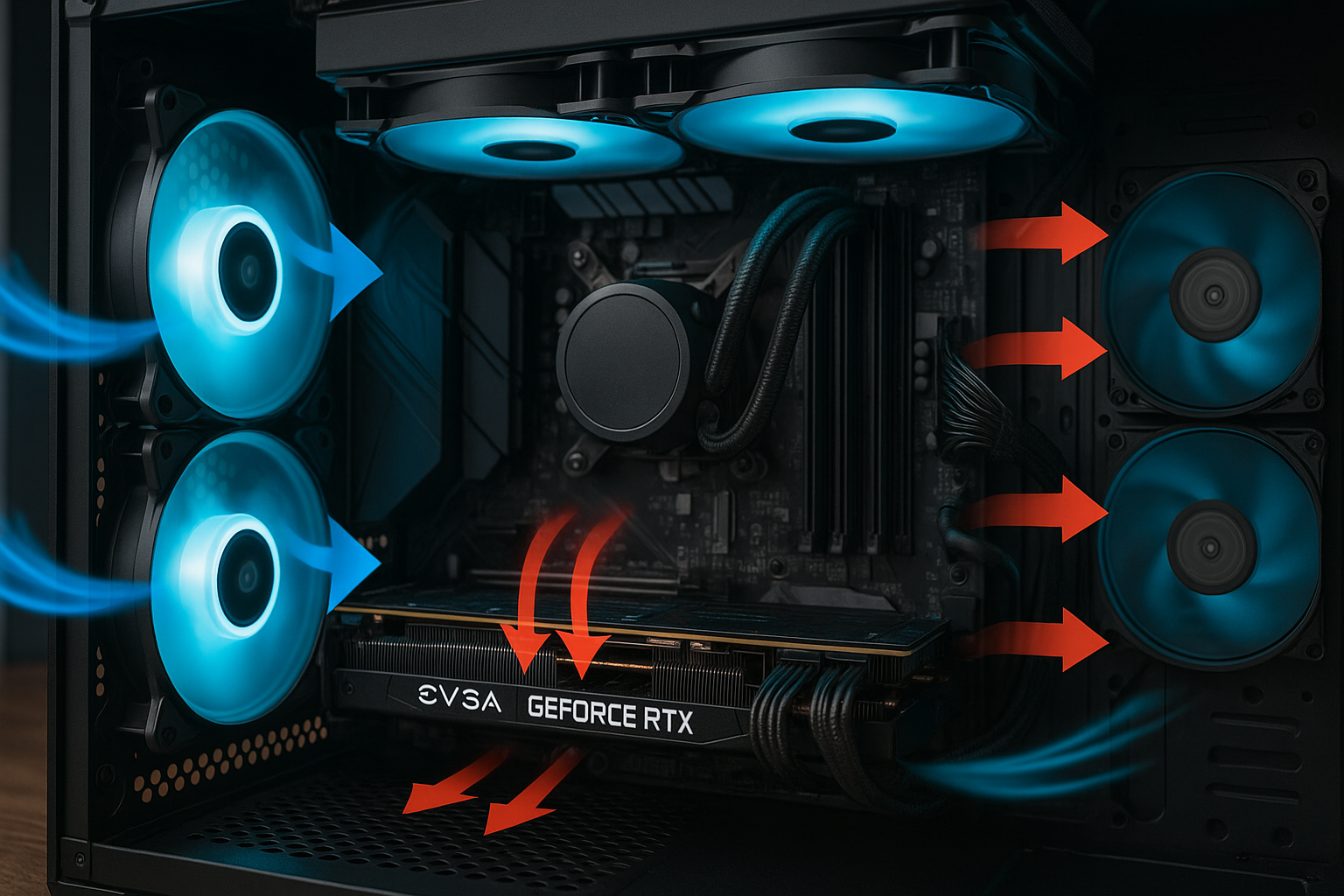When it comes to building a high-performance PC, most people focus on the CPU, GPU, RAM, and storage. But one element that’s often underestimated — yet critical for system stability and longevity — is cooling.
A well-cooled PC not only runs faster and quieter, but it also lasts longer. In this article, we’ll explore the different types of cooling systems, how heat affects your components, and how to design a build that stays cool under pressure.
Why Is Cooling So Important?
Every electronic component in your PC generates heat when it’s in use. If that heat isn’t properly dissipated, it leads to:
- Thermal throttling (automatic slowing down to prevent overheating)
- Reduced performance
- System instability or crashes
- Premature hardware failure
Proper cooling helps maintain optimal operating temperatures, ensuring your components perform at their full potential for as long as possible.
How Heat Affects Key Components
CPU
The CPU is one of the most heat-intensive components. Under heavy load, temperatures can spike quickly. Without effective cooling, your CPU will throttle or shut down to protect itself.
GPU
Modern graphics cards also generate significant heat, especially during gaming or rendering. High-end GPUs often come with their own cooling, but system airflow still plays a big role.
VRMs & Chipsets
Voltage regulators and chipset areas on the motherboard need indirect cooling from case airflow. Poor airflow can reduce their lifespan or cause power instability.
Storage Drives
SSDs, especially NVMe models, can get hot during continuous data transfers. Excess heat can lead to slower speeds and long-term wear.
Types of Cooling Systems
There are two main categories: air cooling and liquid cooling.
1. Air Cooling
The most common and cost-effective solution.
CPU Air Coolers:
- Consist of a heatsink and fan
- Vary in size and performance
- Rely on case airflow to move heat out
Pros:
- Affordable
- Reliable and simple to maintain
- Plenty of good models available (Cooler Master Hyper 212, Noctua NH-U12S)
Cons:
- Bulky (may not fit in small cases)
- Less efficient than liquid cooling at high loads
2. Liquid Cooling
Uses liquid to transfer heat from the CPU (or GPU) to a radiator, where fans cool it down.
Types:
- AIO (All-in-One): Pre-assembled, easy to install
- Custom loops: Advanced, fully customizable cooling systems
Pros:
- More efficient cooling (especially for overclocked systems)
- Sleeker look, less bulk around the CPU
- Often quieter under load
Cons:
- Higher cost
- Potential for leaks (low risk with quality AIOs)
- Slightly more complex installation
Case Airflow Matters
Your CPU or GPU cooler is only as good as the airflow inside your case. If hot air builds up and can’t escape, even the best coolers will struggle.
Basic airflow layout:
- Intake fans (front/bottom): Bring cool air in
- Exhaust fans (top/rear): Push hot air out
Aim for positive pressure (more intake than exhaust) to reduce dust buildup.
Tips:
- Use mesh-front cases for better airflow
- Avoid blocking airflow paths with cables
- Install dust filters and clean them regularly
Cooling the GPU
While GPUs come with their own fans, cooling them better can enhance performance and longevity.
To help cool your GPU:
- Ensure front-to-back airflow
- Use vertical mounting only with good spacing
- Increase case fan speed during gaming
- Consider aftermarket GPU support brackets with fans
Choosing the Right Cooler for Your Build
Your cooler choice depends on several factors:
| Use Case | Recommended Cooler |
|---|---|
| Basic Office PC | Stock air cooler or low-profile air cooler |
| Mid-range Gaming | Mid-size tower air cooler (e.g., be quiet! Pure Rock) |
| High-End Gaming / Editing | Large tower air cooler or 240mm AIO |
| Overclocked System | 280mm+ AIO or custom water cooling |
Also check cooler clearance in your case and RAM height compatibility (some air coolers may block taller RAM modules).
Monitoring Temperatures
Always monitor system temperatures after building or upgrading your PC.
Recommended tools:
- HWMonitor
- CoreTemp
- MSI Afterburner
- HWiNFO
Set fan curves in BIOS or use software like Fan Control to fine-tune your cooling profile for quieter operation when idle and faster speeds under load.
Cooling Myths to Avoid
- ❌ “More fans = better cooling”
→ Not always. It’s about balanced airflow and quality fans, not quantity. - ❌ “Liquid coolers are always quieter”
→ Not true. Some have noisy pumps or fans. - ❌ “You don’t need cooling if you’re not gaming”
→ Even light tasks can overheat poorly ventilated systems.
Final Thoughts: Keep It Cool, Keep It Efficient
Cooling is not just about preventing crashes — it’s about maximizing performance, protecting your investment, and creating a system that runs smoothly, quietly, and reliably for years to come.
Whether you go for air or liquid cooling, the key is to plan your build for airflow, use quality parts, and keep things clean and organized.
In short: if you want your PC to perform like a beast, cooling is non-negotiable.
